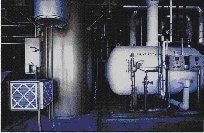San Francisco’s St. Luke’s Hospital complex comprises of four buildings, ranging from 25 to 90 years old. Heating the building required 26,000,000 Btuh, an expensive requirement that had been fulfilled for about 50 years by a high-pressure steam boiler.

Regulations in the State of California stipulate that a stationary licensed boiler attendant must be present 24 hour a day, 365 days a year on any direct-fired steam system that produces over 15 lb of high-pressure steam. As of last year, the cost of St. Luke’s boiler attendants in wages and benefits had grown to $350,000 yearly. The State of California does not require a licensed boiler operator with a thermal fluid heating system that functions within a closed loop at a very low pressure. Hot oil is pumped through unfired steam generators to produce steam without high pressure.
Advantages of Thermal Fluid Heater
Case Study 1
The hospital saw the need to move from direct-fired steam generation to a modern thermal fluid heater. The job required removing the 12 by 25 ft steam boiler and setting up three 6,000,000 Btuh Fulton thermal fluid heaters, as well as two 10,000,000 Btuh oil-to-unfired steam heat exchangers. The job was completed in five months; fortunately, the steam header and steam condensate piping did not have to be exchanged. Because the steam is produced in unfired pressure vessels, the 60 lb of high-pressure steam can be supplied by the new system without a stationary attendant as required by direct-fired steam boilers.
Honeywell provided micro-based DDC controls and Model 7,800 Burner Controls for the new system and served as the general contractor. The changeover to thermal fluid heaters also enabled the hospital to reassign the licensed boiler operators to other tasks.
The direct-fired steam boiler was oversized and consumed energy insufficiently each time it recycled. With the new system, one 6,000,000 Btuh unit stays in continuous operation; the others only come online when the load makes it necessary. This has led to a projected yearly saving of 18% of the hospital’s natural gas bill.
The new thermal fluid heaters are charged with Paratherm NF Heat Transfer fluid. Mike Andress, Project Manager for Honeywell, stated the fluid was doing an outstanding job, without any complaints. Since the NF fluid is rated for 600 °F and provides precise even temperature control, it has no difficulty in providing the 300 °F heat required. Furthermore, the fluid has very high heat transfer coefficients for enhanced efficiency. It is also non-poisonous, non-hazardous and non-fouling. At the end of its use cycle, it can be mixed with other spent lube oils and sent to a local recycler – another cost saving for the hospital.
Case Study 2
At St. Joseph’s Medical Center in Stockton, California, the transition from high-pressure steam boilers to Fulton thermal fluid heaters and Fulton 9 1/2 hp boilers was done in 1994. While the new system produced sufficient steam for most hospital functions, extra steam pressure was required to run the laundry.
Jerry Cotton, Manager of Maintenance at St. Joseph’s, explained that the changeover had required setting up three Fulton 9 1/2 hp tubeless steam boilers. These units produce less than 15 hp and thus do not require the 24 hour boiler attendant required by Californian law.
Once the system was operational, St. Joseph’s laundry identified one minor issue – the new system could not produce the 125 psi steam pressure needed by the ironer; it was restricted to a maximum of approximately 80 psi. The issue was rectified with the fixing of a supplemental thermal fluid heater. This hot oil heater works in a closed loop system and delivers heat to the ironer, which is within a 2 °F temperature range. The unit has been in service for more than two years without issues. Similar to St. Luke’s, St. Joseph’s charges all the thermal fluid heaters with Paratherm NF heat transfer fluid.
Case Study 3
A different situation exists at the Sutter Roseville Hospital in Roseville, California. This new unit is a 340,000 sq ft general hospital with four new thermal fluid heaters. Dale Holt, the Maintenance and Operations Supervisor said that the system was engineered to run two heat transfer units and use the other two as backups. The backups are fixed to take over automatically if the steam temperature produced by the main units falls below a specific point.
So as to produce 280 °F steam, the hospital maintains the heat transfer oil at 450 °F. The closed loop thermal fluid system is used to offer all of the 700 bhp of chief plant steam required for building heat, sterilization and kitchen. To protect the hospital from environmental issues, the hot oil heaters were built with low emission burners to match 30 ppm NOx requirements.
The hot oil heaters, hot oil pumps, expansion/deaerator tank and unfired steam generators were skid mounted and pre-piped at the Fulton factory. Piping was taken apart for shipping but match marked for simple reassembly at the job site. The system is fired with natural gas, and there is a 20,000 gal oil storage tank that can take over during an emergency.
The system has been functional since June 21st 2017. Holt stated that in general the system is functioning well, and the heat transfer fluid in the system is performing as expected.
The Sutter Rosevill Hospital, like St. Joseph’s Hospital and St. Luke’s Hospital, found that a thermal fluid heating system costs considerably less to run than a direct-fired steam boiler system.

This information has been sourced, reviewed and adapted from materials provided by Paratherm.
For more information on this source, please visit Paratherm.